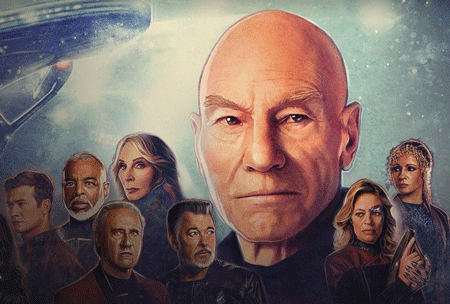Would anyone under 30 watch “Picard?”
Like “The Mandalorian” or “Loki,” the Paramount+ series “Star Trek: Picard” is unlikely ever to attract new viewers. But is that a problem?
By Brad Berens
Here’s a newsflash to no one who has met me. I’m a nerd.
One piece of evidence from a vast jigsaw puzzle of nerdery: Friday night, I watched the third episode of the third and final season of Star Trek: Picard on Paramount+.

Credit: Paramount+
I loved it. However, it would be unthinkable for me not to love it.
I’ve been watching Star Trek in all its incarnations since I was a teenager, starting with reruns of the original series after school on Channel 5 in Los Angeles. I took my grandfather to see Star Trek II: The Wrath of Khan in Westwood, California in 1982 because Papa was a Trek fan, too.
A few years later at university, I gathered with other fans for the collective nerdgasm that was the premiere of Star Trek: The Next Generation (TNG, 1987). In the 1990s, my patient wife, La Profesora, watched Star Trek: DS9 and Star Trek: Voyager with me in our courting days, and more recently she watched the first two seasons of Star Trek: Discovery. (She dropped out in Season 3. Fair.)
Picard brings Patrick Stewart (82) back to his iconic role as retired Admiral Jean-Luc Picard, former captain of the Starship Enterprise, which he played across seven seasons on television and four movies, ending with Star Trek: Nemesis in 2002. The first season of Picard came out in 2020, 18 years after Nemesis. I enjoyed Season 1, thought Season 2 was meh, and think that Season 3 is a different animal altogether.
Although the characters from TNG had fun-for-the-fans cameos in the first two seasons of Picard (and one actor, Brent Spiner, played multiple characters including “Data,” the android from TNG), the old characters were not the focus of the sequel show. Instead, the series dug into Picard’s back story, motivations, and musings about his final years, while also enjoying rollicking adventures in space.
The studios don’t design narrative extensions to stand on their own. Instead, they are for viewers who are already fans. Narrative extensions extract value from existing audiences instead of creating new audiences or growing existing ones. They are cash out exercises rather than investments.
Season 3 of Picard abandons the character development of the first two seasons. Instead, it is a reboot of TNG, a last hurrah for the actors and characters from that series, and an aria of nostalgia for Trek fans.
Although he has been credited as only a Special Guest Star, Jonathan Frakes, who plays Picard’s second in command William Riker, has been next to Stewart every step of the way. (Frakes also directs some episodes.) Episode 2 brings back Gates McFadden as Beverly Crusher and Michael Dorn as Worf. Episode 3 features a cameo by Marina Sirtis as Deanna Troi. The collateral posters and images marketing the show reveal that the rest of the crew will follow in later episodes.
Nerd Digression: Picard S3 is a lot like Star Trek: The Final Frontier (1989), which was a final ovation for the original series. Also, the plot of Picard S3 has some “haven’t we been here before?” overlaps with a key subplot in Khan, but no spoilers.
It’s inconceivable that anybody would watch Season 3 of Picard if they didn’t have fond memories—or at least memories—of TNG. I have those memories, so I’m loving the show, but from both aesthetic and business perspectives, this is curious.
Is This a New Genre?
Like a cluster of Marvel mini-series (Loki, The Falcon and the Winter Soldier, Wanda/Vision) and Star Wars mini-series (The Mandalorian, Andor) on Disney+, Picard is an example of a new kind of television, a genre that (for want of a better term) I’m calling “the narrative extension.”
The studios don’t design narrative extensions to stand on their own. Instead, they are for viewers who are already fans. Narrative extensions extract value from existing audiences instead of creating new audiences or growing existing ones. They are cash out exercises rather than investments.
Narrative extensions are longer than movies (seasons of Picard are 10 roughly hourlong episodes) but shorter than a conventional 22-episode season of a TV drama. (Those longer conventional seasons primarily exist for the benefit of advertisers who want consistent audiences for several months. Advertiser logic only partially applies to Paramount+, which has both an ad-supported and ad-free offering.)
Picard asks viewers to make a different kind of decision than either a movie or a conventional series. Paramount would never have greenlit a movie version of Picard because they would not bet that enough people would leave their couches and plunk down $15 per ticket to watch an octogenarian on a spaceship.
Likewise, the alien-of-the-week approach that well-served the broadcast versions of Star Trek probably wouldn’t work with Picard because the effects budgets are huge, the famous actors are more expensive than unknowns, and those actors don’t want to be locked up on location for half a year. Also, viewers might not show for that long.
Instead of taking positive action, Picard asks viewers for inaction: don’t bother canceling your Paramount+ subscription. “There’s enough here; you should stick around.”
As a lifelong Star Trek fan, I have swallowed the hook on this strategy. Back when this streamer was called CBS All Access, I joked that it should have been called Star Trek All Access. After Picard is over, the final season of Discovery will pop up, with other shows (Prodigy, Lower Decks, Strange New Worlds) coming later in the year. All of the old series are available on demand at any time. I’m not going anywhere.
But are there enough people like me to sustain Paramount+? I doubt it. The streamer doesn’t have many original series outside of Star Trek.
One of the most popular Paramount produced series, Yellowstone, plays on the smaller Paramount Network cable channel and streams on rival service Peacock. Paramount+ has two Yellowstone prequel series (1883 and 1923), but it’s a bad bet that enough folks will follow the breadcrumbs to Paramount+.
Lots of media watchers expect further consolidation among the studios and streamers, so I’m enjoying the current steady supply of Star Trek.
While I can.
__________

Brad Berens is the Center’s strategic advisor and a senior research fellow. He is principal at Big Digital Idea Consulting. You can learn more about Brad at www.bradberens.com, follow him on Post and/or LinkedIn, and subscribe to his weekly newsletter (only some of his columns are syndicated here).
See all columns from the Center.
March 8, 2023

